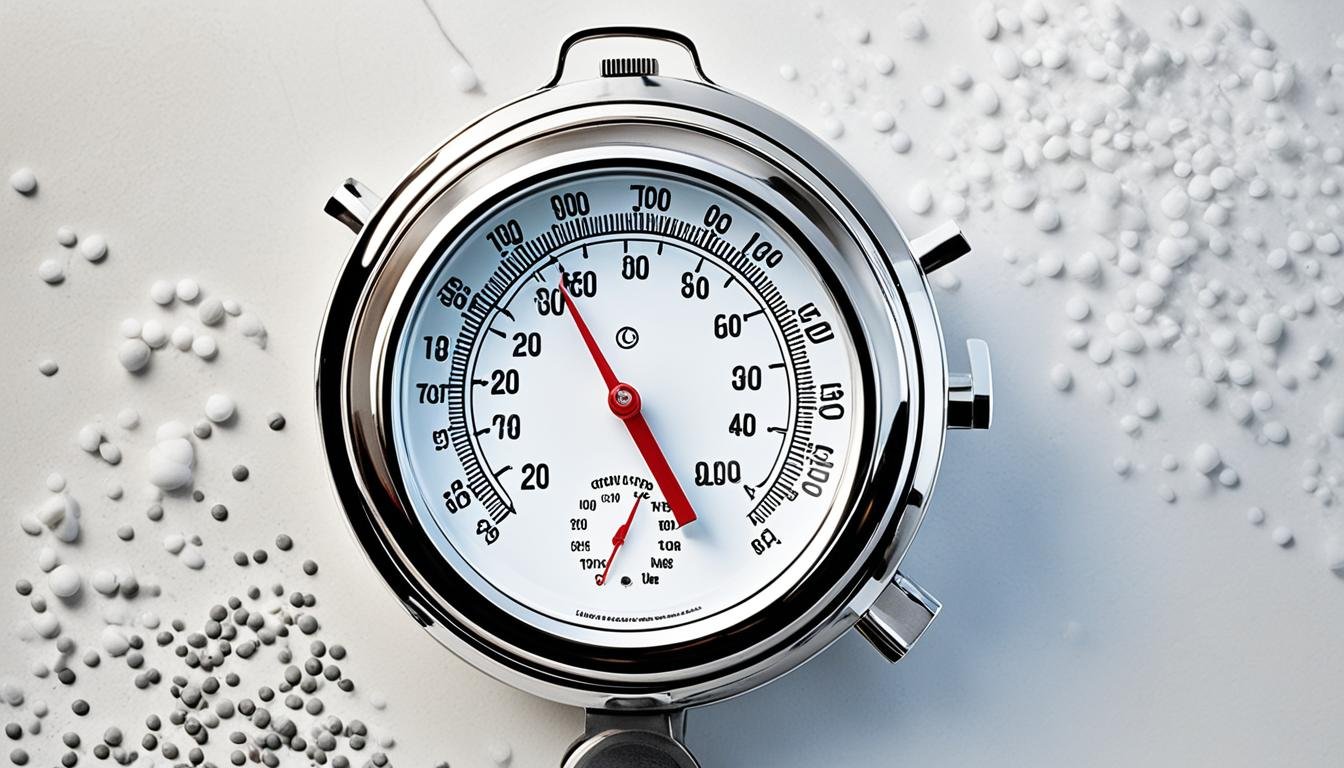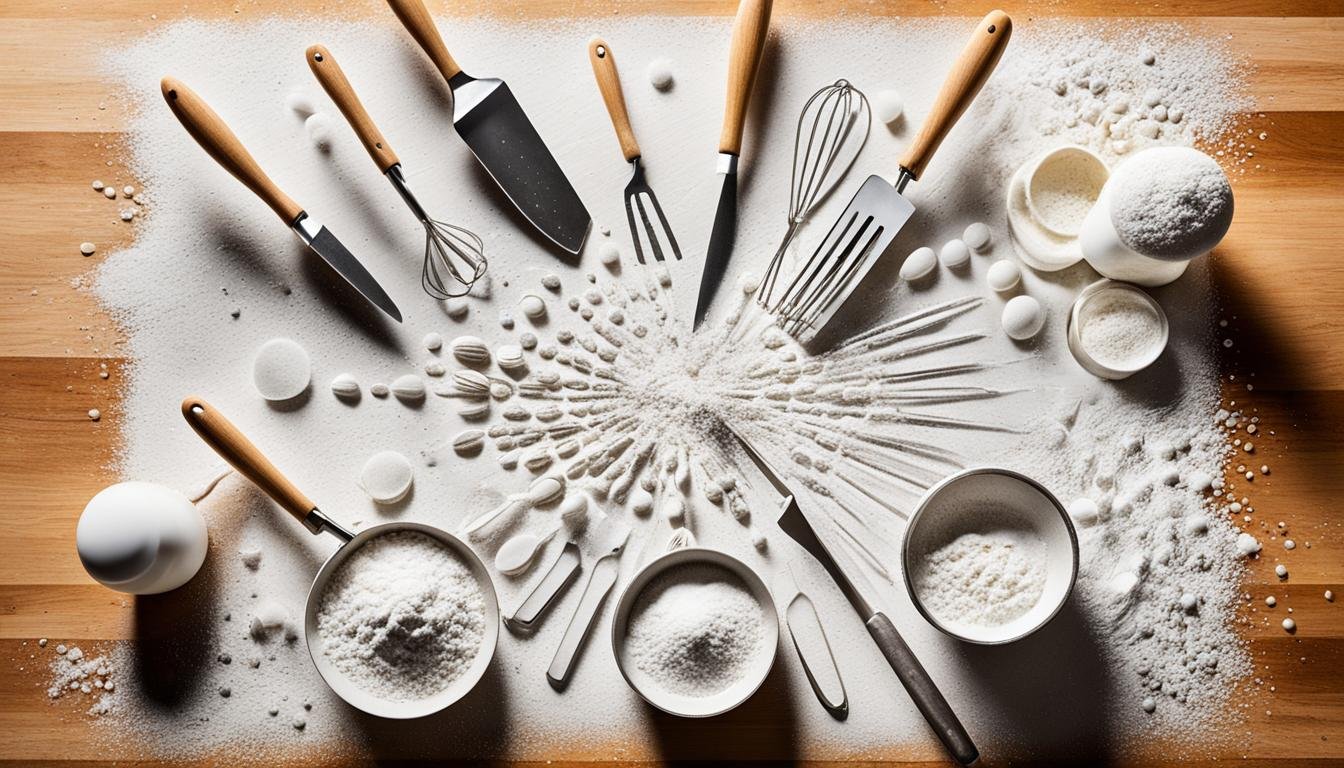Welcome to the world of culinary techniques, where cooking becomes an art! Whether you’re a pro at home or just starting, knowing the basics is crucial. It helps you improve your skills and make meals that wow even the pickiest eaters.
Culinary techniques cover a lot, from cooking methods to kitchen skills. They’re the building blocks of any great dish. Learning how to use a knife right and understanding flavor through seasonings are key to making amazing food.
Getting good with a knife is a must for any cook. Cutting veggies, fruits, and meat with precision changes the game. It makes your dishes look and taste better. Skills like dicing, slicing, or julienning will turn you into a pro.
But there’s more! Seasonings are a big deal in cooking. They can turn a simple dish into something special. With the right mix of salt, pepper, herbs, and spices, your food will stand out.
Temperature is also crucial. Knowing the best cooking temperatures helps your dishes come out perfectly every time. Whether it’s searing a steak or baking a soufflé, getting the temperature right is key.
Having the right ingredients in your pantry is important too. We’ll look at the essentials that can make any dish better. From sauces to spices, knowing what to keep on hand makes cooking easier.
Finally, we’ll talk about balancing flavors for delicious meals. Picking the right ingredients and mixing sweet and savory is key. It’s what makes dishes memorable and keeps people coming back for more.
Key Takeaways:
- Mastering culinary techniques is essential for elevating your cooking skills.
- Knife skills play a crucial role in the final presentation and texture of your dishes.
- Understanding seasonings allows you to unlock a world of flavor.
- Temperature control is vital for cooking various foods perfectly.
- A well-stocked pantry with essential ingredients is a chef’s secret weapon.
Knife Skills: The Art of Precision
Learning how to use knives well is key for any chef or home cook. Being able to use knives with skill can really boost your cooking skills. It makes food preparation better.
With good knife skills, you can turn simple ingredients into amazing dishes. It doesn’t matter if you’re a pro chef or cooking for your family. Knowing how to use a knife well is a must.
Using knives right makes you safer in the kitchen and helps you work more efficiently. A sharp knife with the right technique means clean cuts and less chance of accidents.
Let’s explore some important knife skills every cook should know:
- 1. Slicing: Slicing cuts food into thin, even pieces. It’s used for meats, fish, fruits, and veggies.
- 2. Dicing: Dicing cuts food into small, even cubes. It’s for things like onions, carrots, and potatoes.
- 3. Chopping: Chopping cuts food into bigger, uneven pieces. It’s for herbs, nuts, and some veggies.
- 4. Mincing: Mincing chops food into tiny pieces. It’s for garlic, ginger, and herbs.
Mastering these skills saves time and makes your food look great. Always keep your fingers in and use a stable board to stay safe.
Now you know how crucial knife skills are for cooking. It’s time to sharpen your knives and start practicing! With hard work and practice, you’ll soon be a pro at using knives.
The Alchemy of Flavor: Understanding Seasonings
Seasonings are the magic in cooking, turning simple meals into amazing dishes. They include herbs, spices, and other techniques that make food taste great. Learning to use seasonings well is key for any chef.
Seasonings add depth and aroma to our food. They make dishes taste better and smell amazing. Using different seasonings can take your cooking to the next level.
It’s important to balance flavors when seasoning. You can use sweet, savory, bitter, or spicy seasonings. Mixing these can create a perfect taste. For instance, a little black pepper can balance the sweetness in a dish.
Layering seasonings is another great way to enhance flavors. Adding them at different cooking stages builds flavor layers. This makes the dish more complex. For example, start with garlic and onion powder, then add fresh herbs later.
There are many seasoning techniques to try. From dry rubs to herb-infused oils, each method adds unique flavors. Trying new techniques lets you explore flavors and make dishes that show off your style.
Choosing the Right Seasonings
When picking seasonings, think about the flavor you want and the dish’s ingredients. Each seasoning has its own taste and works best with certain foods. For example, rosemary is great for roasted meats, while cumin is perfect for Mexican or Middle Eastern dishes.
Seasoning is all about knowing how each flavor works together. With practice and knowledge, you can create dishes that are truly amazing.
Temperature Matters: Mastering Cooking Techniques
Temperature control is crucial in cooking. It affects the outcome of many cooking techniques. From sautéing to roasting, knowing how to manage temperature is key. It helps improve your cooking skills and makes dishes taste great every time.
Each cooking method needs the right temperature to work well. By controlling heat, you can change ingredients in amazing ways. This creates different textures, tastes, and looks. Let’s see how temperature changes cooking techniques:
1. Sautéing
Sautéing cooks food quickly in a bit of oil or fat over high heat. This high heat makes food brown and caramelize, giving it a tasty and crispy texture. Keeping an eye on the temperature ensures food cooks evenly and doesn’t burn.
2. Roasting
Roasting cooks food in an oven at moderate to high temperatures. It makes the outside brown and the inside stay juicy. Adjusting the temperature helps get the right doneness and caramelization for meats, veggies, and more.
3. Grilling
Grilling gives foods a smoky flavor. Whether with charcoal or gas, controlling the temperature is key. Knowing the best heat for different foods is important for delicious grilled dishes.
4. Boiling
Boiling is a simple but versatile method used for many dishes. The boiling temperature changes the texture and taste of ingredients. Keeping the boil right prevents over or undercooking, making sure ingredients are perfect.
Getting good at temperature control lets you make dishes like a pro at home. Knowing how cooking methods and temperature work together lets you try new things and get great results every time.

Temperature control is key in cooking. It helps you get the results you want and lets you be creative. So, next time you cook, remember to watch the temperature closely. It really makes a difference in your cooking.
The Pantry Paragon: Stocking Essentials
Having a well-stocked pantry is key to making tasty dishes. The pantry is the kitchen’s core, offering the base for many recipes. With essential pantry items, you can improve your cooking and be ready for any recipe.
Let’s explore the must-have ingredients for every kitchen:
Quality Oils
High-quality oils like extra virgin olive oil and vegetable oil are crucial. They’re used for sautéing and making salad dressings. These oils bring depth and flavor to your meals.
Vinegars
Vinegars, including balsamic and apple cider vinegar, elevate your dishes. They add a tangy flavor to dressings, marinades, and sauces.
Canned Goods
Canned tomatoes, beans, and fish are pantry staples. They offer convenience and flavor when fresh ingredients are scarce. These items are great for soups, stews, and quick meals.
Grains and Pasta
Grains like rice and quinoa, along with various pasta types, are key pantry items. They’re perfect for dishes like risottos and stir-fries. These staples add texture and substance to your meals.
Organizing and labeling your pantry can make it more efficient. This way, you can easily find ingredients and avoid duplicates. A well-stocked pantry lets you try new flavors and ingredients, creating amazing dishes.
In the image above, you see a well-organized pantry with items like oils, grains, and canned goods. A tidy pantry makes finding ingredients easy and boosts creativity in the kitchen.
Balancing Act: Creating Harmonious Meals
Creating a well-rounded meal is more than just filling your belly. It’s about finding the perfect mix of flavors, textures, and nutrients. A balanced meal has the right amount of proteins, carbs, and veggies. These not only fill you up but also keep you healthy and feeling good.
Culinary creativity is key to finding this balance. By trying new cooking methods and ingredients, you can make your meals amazing. Plating your food right also makes it look great, making it a treat for your eyes and taste buds.
Having good kitchen skills is the base of making meals that work well together. Knowing how to cook at the right temperatures and how to chop ingredients is crucial. These skills let you cook with precision and confidence. With practice, you can turn simple ingredients into something truly special.
So, next time you cook, focus on balance. Let your creativity with food shine by mixing different flavors and textures. Use your skills in plating to make your dish look inviting. And, use your kitchen skills to put everything together into a meal that tastes amazing. Remember, a balanced meal is not just about eating; it’s about enjoying an experience that pleases your senses and soul.


